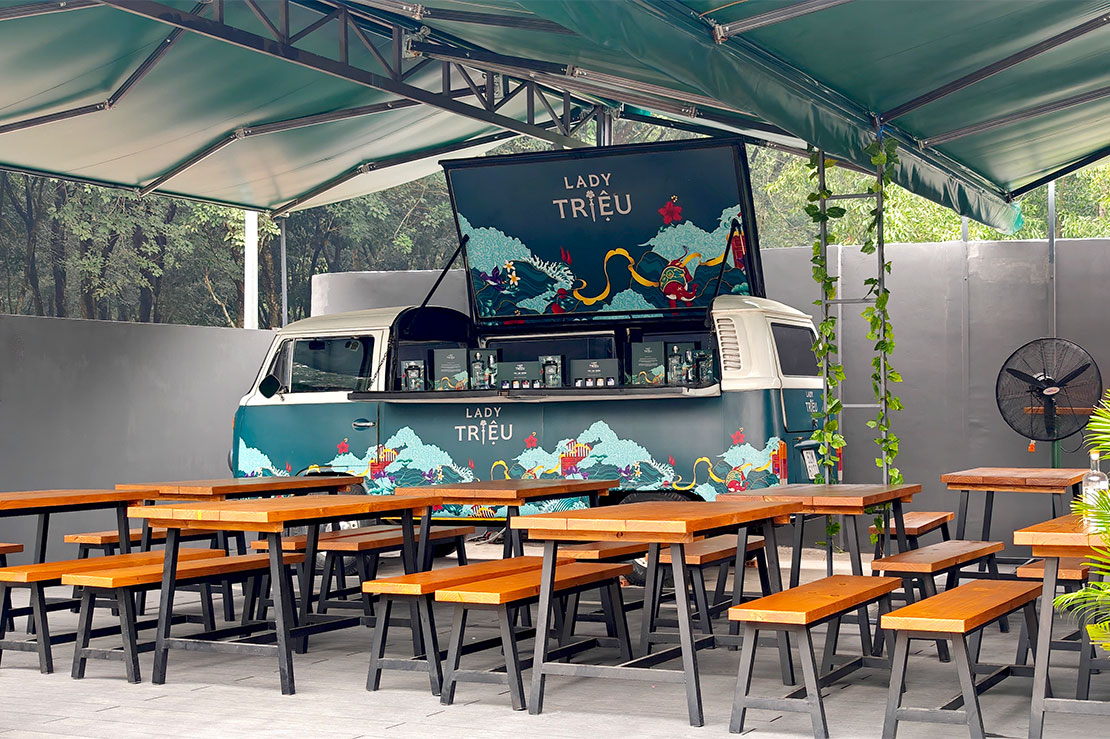We were picked up in the heart of Ho Chi Minh City on a Saturday morning, inching our way through the city’s honking traffic before slipping into the quiet chaos of Củ Chi, a suburb about an hour outside the capital.
The van made its final turn and there it was: Lady Triệu Distillery. Opposite a thicket of jungle, two gleaming stills, an elegant swan neck and a stately column, rose into view from the entrance. The space inside was vast, clean, and meticulously organised.
Our guide for the day was Javin Chia, master distiller, equal parts scientist and storyteller. “Do you remember simple distillation from secondary school?” he asked with a grin. I had no idea what he was referring to; in my school days, no one trusted us with equipment that involved heat. Still, I went along and nodded politely as he launched into a clear, engaging explanation of how water and ethanol separate.
Before the science lesson could go too far, a welcome interruption arrived: a crisp Gin & Tonic. At 11am, with our palates still fresh, it became our taste of the day, Lady Triệu Gin, capturing the soul of Vietnam in its spirits.
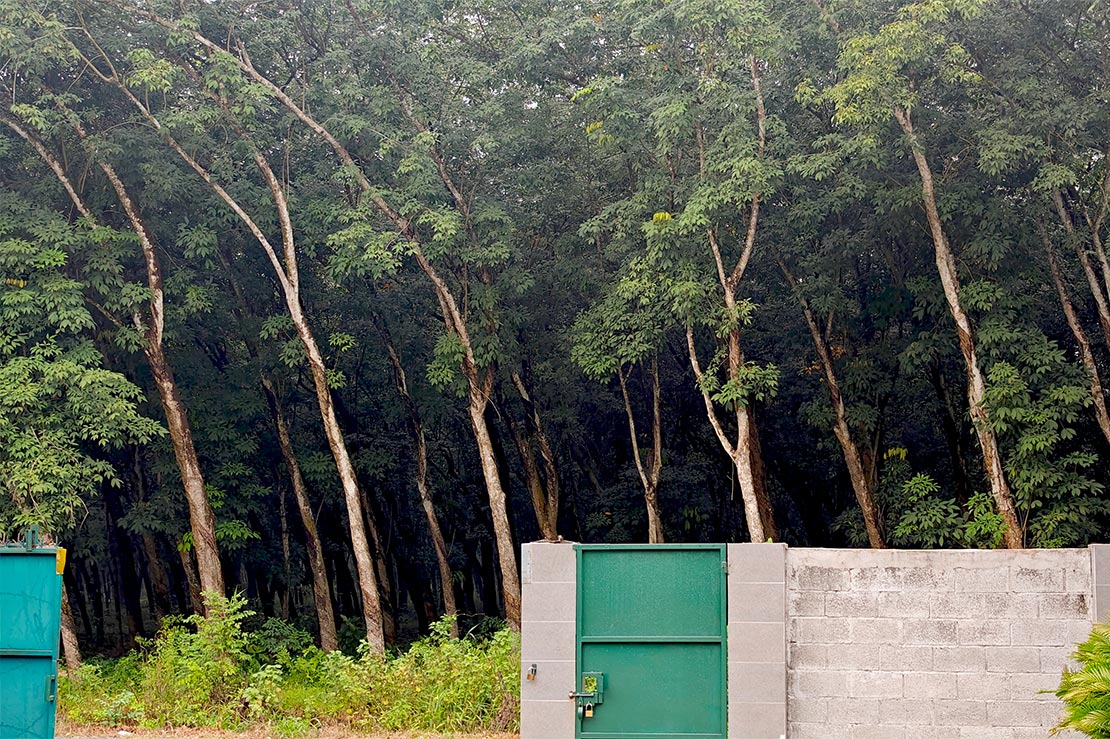
The Science of Flavour
After the welcome sip, Javin led us deeper into the distillery. The scale of the operation became clear, stainless steel tanks lined neatly along one side, the copper pot still gleaming like a showpiece in the centre. The place felt both industrial and strangely serene, a laboratory of aromas.
The base of Lady Triệu gin is rice spirit from the Mekong Delta, distilled off-site in towering column stills to a 96% purity. It’s potent, almost unapproachably so. “If I leave the lid slightly open, half the tank will be gone in a day,” Javin jokes, reminding us just how volatile high-proof ethanol can be.
Instead of using it neat, the spirit is brought down to 65.5% ABV. Why such a precise number? Javin explains:
“Botanicals have compounds that are water-soluble, alcohol-soluble, and oil-soluble. If I only use water, I lose half the flavours. If I only use alcohol, the same problem. But at 65.5%, I get the best spectrum of extraction.”
Every drop of water used comes from an on-site reverse osmosis system, ensuring mineral-free consistency. "That way, the flavour of the gin speaks for itself.”
From here, production follows four stages: maceration, distillation, dilution, and bottling. Each, however, is fine-tuned to respect the delicacy of the botanicals.
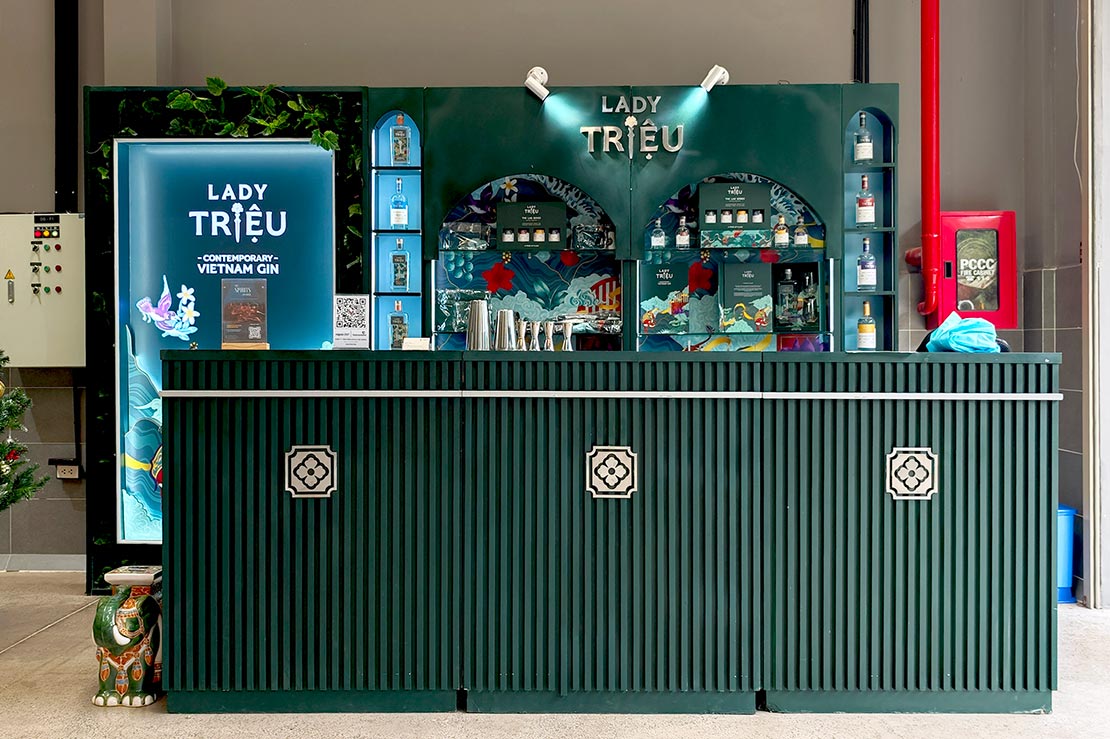
The bar that serves the welcome drink at Lady Trieu's distillery. [Photo: Kim Choong]
Maceration and the Botanical Room
We stepped into the botanical room, and it instantly became my favourite space. Cool and climate-controlled, it smelled of pine and citrus, flowers and spice. Burlap sacks, not plastic, contained juniper berries and stacked against one wall. “Juniper is resinous. It still has oil in it,” Javin says, crushing one between his fingers so we could smell the piney freshness. “If it dries out, we lose that aroma. Humidity keeps them alive.”
“Juniper isn’t grown in Vietnam,” he explained, “so we bring it from Tuscany. Everything else, lotus, jasmine, chrysanthemum, kumquat, galangal, is Vietnamese.” All these botanicals are stored under nitrogen, the same technique used in potato chip packaging, to prevent oxidation. “It’s why the jasmine petals are whole, not dust,” he added.
For citrus, we peel it by hand. For flowers, we keep them whole. Each botanical is prepared differently before maceration.” He compared the process to making a giant tea bag: the botanicals steep in the diluted spirit until it becomes a powerful, aromatic infusion. “From there, we distil it, and that’s when the magic happens,” he said, ushering us towards the centre of the distillery where the stills sat.
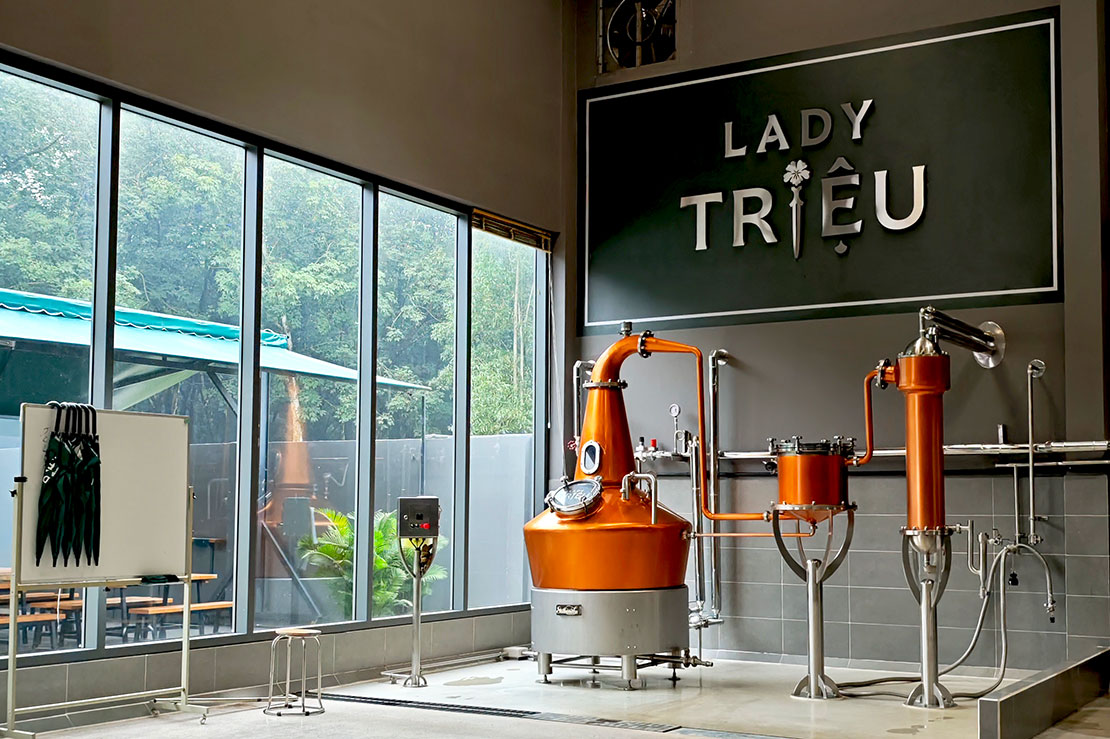
The shiny stills are custom-made in Tuscany for Lady Trieu gin. [Photo: Kim Choong]
Distillation in the Still Named After Lady Triệu Herself
That tea is fed into the curvy copper pot still built in Tasmania and shipped across the ocean to Củ Chi. Javin introduced it with a grin: “Every distillery names their still. Ours is called The Lady.”
Unlike hybrid stills that strip spirits into light refinement, this pot still produces a robust, full-bodied gin, closer in design to Scotch whisky stills. “It’s closer to what you’d see in Scotland,” Javin explained, “something that gives you volume and depth.”
He walked us through the process like a patient teacher. The macerated liquid, essentially a strong alcoholic tea, was gravity-fed from the upstairs tanks into the still. Water was added to dilute it to around 50%, then the steam coil beneath fired it into a slow boil.
Delicate ingredients, like jasmine or hibiscus, don’t go into the pot. They’re placed in a vapour-infusion chamber, “Imagine boiling jasmine for four hours,” Javin says, pulling a face. “It’d taste awful. This way, it stays fresh, floral, and alive.” Hot vapours gently pass through its copper tubes chilled with water kept strict at 20°C, extracting aroma without cooking the botanicals. “In Scotland, the streams are cold enough on their own,” he quipped, “but in Vietnam, we need a chiller. Otherwise, nothing condenses.”
At this point, the tasting began — not for us, but for Javin. He explained how distillers separate the run into three parts: the heads, the hearts, and the tails. The heads came first, sharp and oily. The hearts were what he was after: smooth, aromatic, the true essence of gin. This was where Lady Triệu's character lived. Javin swirled a glass, nosed it, and smiled. “This is the moment I love most, when all the theory comes together in the glass.”
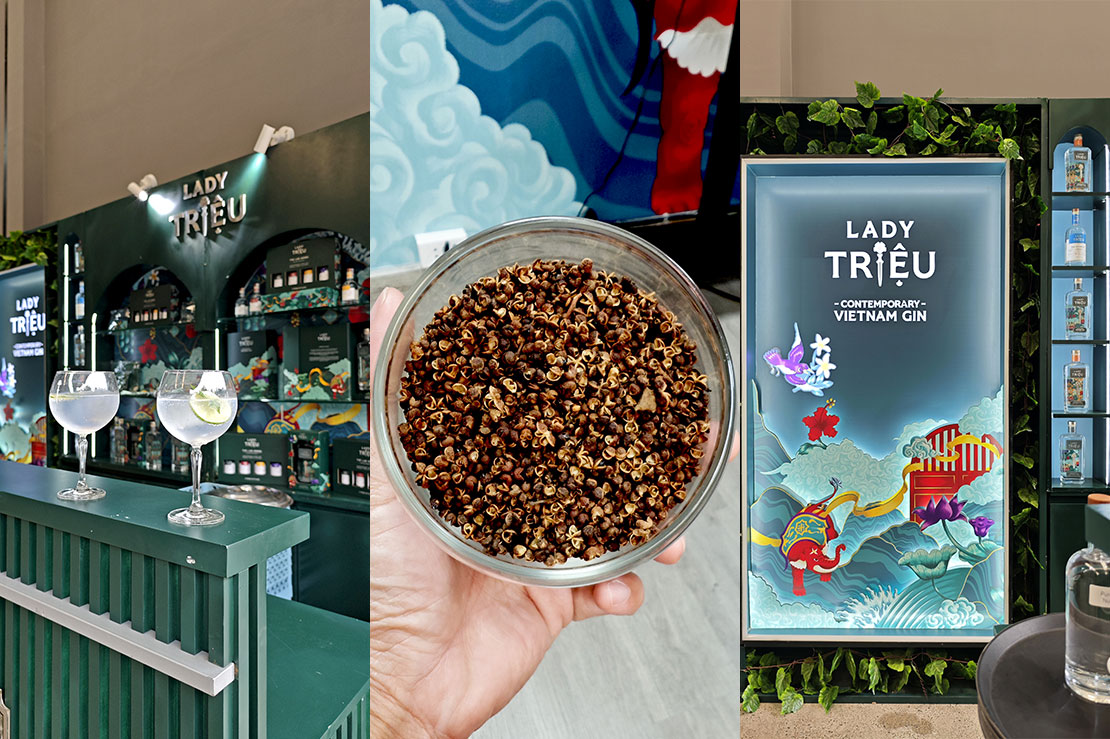
Left and right: Bar in Lady Trieu's distillery; Middle: Cubeb pepper. [Photos: Kim Choong]
Dilution and Bottling
Once the hearts were collected, the gin was far too strong to drink. At over 80% ABV, it needed to be brought down to a more civilised 43% bottling strength. That sounded straightforward, just add water, but as Javin explained, it was trickier than it looked.
“Dilution is exothermic,” he said. “Add water too quickly and the tank heats up, releasing volatile compounds. Your gin will smell great in the air, but you’ll lose it in the bottle.” Here, patience is key. Instead, the team adds water in small increments daily, hand-stirring like craftsmen rather than relying on pumps. “It’s also a control point,” he says. “When I stir, I smell it. If something’s off, I’ll know right away.”
From there, the spirit passed through simple filters — nothing fancy, just enough to catch stray bits of juniper or botanicals without stripping flavour. “We don’t want to over polish the liquid,” Javin said. “Every decision up to now has been about preserving aroma.”
The bottling line was equally straightforward: bottles rinsed with RO water, dried with air, filled to measure, corked, labelled, then hand-checked one by one. For the flagship square bottle, with its sword emblem and hibiscus flower, the labels were still applied by hand.
Each bottle carried a batch number linked to samples stored in the distillery’s log. “If someone in Singapore tells me it tastes different from what they had in Vietnam, I can pull the sample and check,” Javin said. It was quality control with a touch of accountability, and he seemed quietly proud of it.
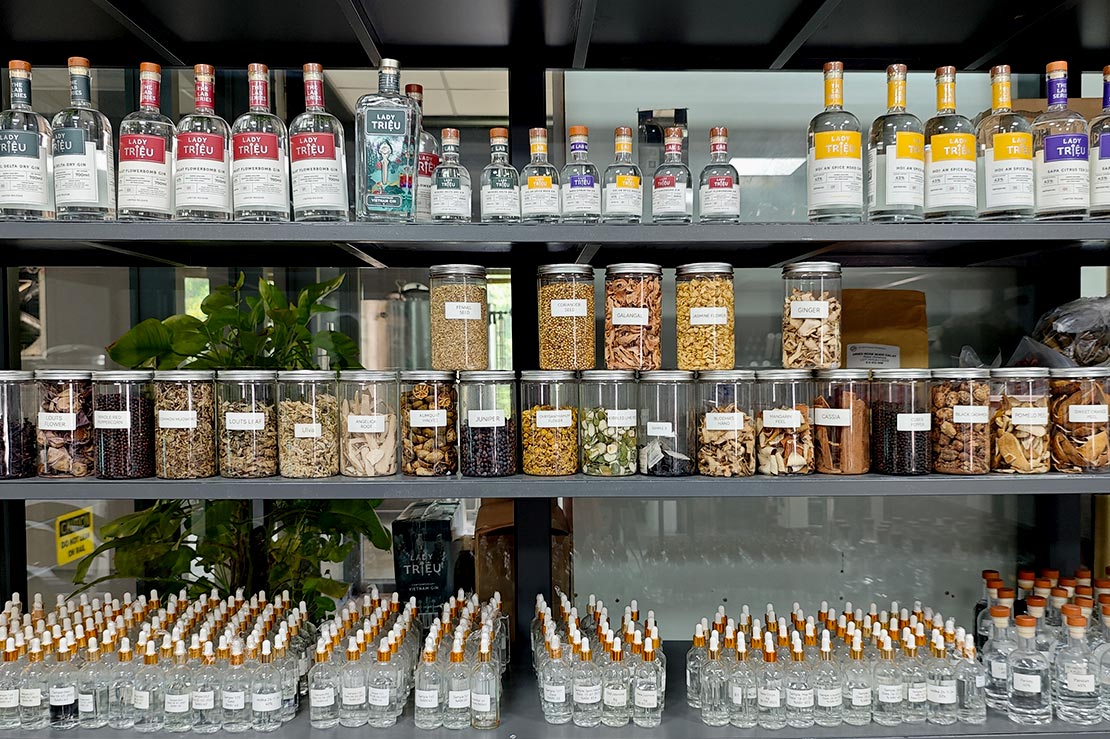
The shelves of botanicals, essences and expressions to make gin. [Photo: Kim Choong]
The Expressions of Vietnam
Lady Triệu is not just one gin. It is a collection of spirits that each reflect a part of Vietnam’s diverse landscape, before converging in their flagship.
Mekong Delta Dry Gin – We began in the south, with a gin inspired by the Mekong River. “It transcends borders,” Javin said, noting how the river threads through five countries before fanning into Vietnam’s delta. The gin mirrored that versatility, clean, classic, juniper-led. Juniper, coriander, and kumquat from the Delta lend it a crisp, traditional backbone. I found it familiar, the sort of gin that could slide into any bar as a London Dry without raising eyebrows. At 43%, it had enough weight to hold up in a Martini, but still felt bright in a G&T.
Dalat Flowerbomb Gin – A celebration of Vietnam’s love for flowers, and as red as the blossoms from that highland region. Jasmine for a high sweet note, chrysanthemum for honeyed depth, and lotus for earthy complexity. “Lotus is like chocolate and earth rolled together,” Javin notes. The aroma was lush and delicate, like walking through a morning flower market. On the palate, it carried a freshness that surprised me, fragrant but not perfumed.
Hoi An Spice Road Gin – Its label yellow like the old town’s walls. This gin was warm, rich, and complex, layered with spices from cubeb pepper, ginger, and cardamom. “We wanted something that could stand up to ginger beer: bold, spicy, and a little unruly.” I could see why. The peppery warmth lingered long after the sip, the kind of gin I’d pair with grilled meats or sip neat on a cooler night. This was the boldest of the lineup so far.
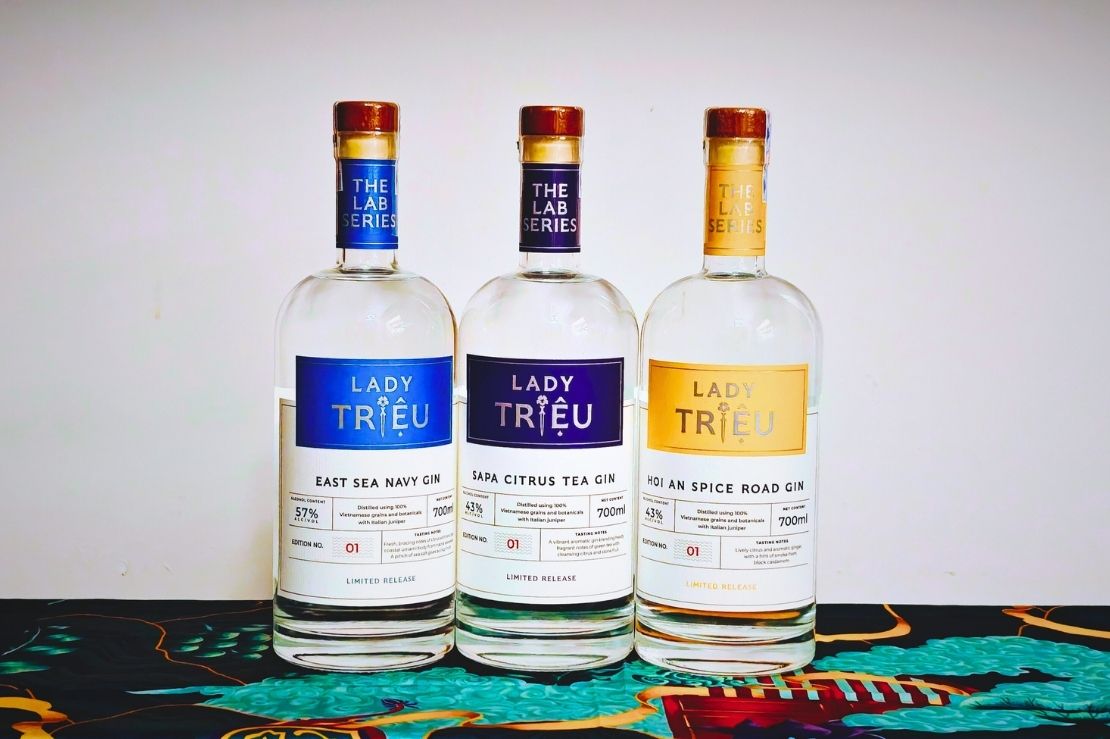
Lady Trieu's East Sea Nacy Giin, Sapa Citrus Tea Gin and Hoi An Spice Road Gin. [Photo: Kim Choong]
Sapa Citrus Tea Gin – We then travelled north to the mountains, where Vietnam’s ancient tea trees still grew. Inspired by the bitter and astringency from these teas, the gin added infused dried citrus peel to open the tannins, designed for martinis: dry, tannic, and the flavour was pronounced. As I sipped, I could imagine it bone-dry and bracing in a chilled coupe.
Contemporary Vietnam Gin – The flagship, weaving all four regions together. Juniper, kumquat, ginger, jasmine, cubeb pepper, and hibiscus combine into a gin that is unmistakably Vietnamese. The hibiscus, chosen as a symbol of the brand's logo, offers bright acidity and ties the flavours together. The bottle itself carried the colours of its predecessors: green, red, yellow, purple, painted into a mural on the distillery wall. The hibiscus note was subtle, almost invisible, but it worked as a bind. To me, this felt like the house statement: distinctly Vietnamese yet recognised as a gin, something to introduce to the world.
East Sea Navy Gin – Bottled at 57%, it leans into maritime heritage. Sea lettuce (ova) brings an unmistakable oceanic aroma, joined by galangal, celery seed, and a whisper of Vietnamese sea salt. “Smell it,” Javin says, handing around a jar. “It’s the beach in a bottle.” A Navy Strength Gin should be a staple at any home bar. It’s perfect for sipping neat when I have a blocked nose.
King Orange Flavoured Gin – The newest expression, built on the intensely aromatic green “cam sành” orange, hand-peeled fresh. A hint of sugar softens the bitter pith. “Most orange gins taste dried or artificial. I wanted the smell of zest lingering on your fingers after peeling.” This would be something for a Breakfast Martini, or a Chinese New Year toasting shot. That’s what I would do.
As we finished the last glass, I leaned back and tried to take in everything I had just seen, smelled, and tasted. Lady Triệu wasn’t only about gin, it was modern Vietnam told through flavour. Each expression carried a piece of geography, history, or culture: the Mekong’s generosity, Dalat’s flowers, Hoi An’s spice routes, the mountain teas of the north, even the ocean itself.
For Javin, that’s the point. “People ask if it’s restrictive to only use Vietnamese ingredients,” he said. “But have you looked at Vietnam? We’ve got mountains, deltas, coastlines, flowers, spices you’ve never heard of. Honestly, I’m spoiled for choice.
It seemed innovation for Lady Triệu Distillery is not confined to flavour. In the lab, rotary evaporators are used to distil botanicals under vacuum, preserving delicate aromas at low temperatures. The results range from rose water to experimental single-ingredient distillates for bartenders, of which we had the opportunity to experience.
Sustainability is an area of interest for the distillery where they turn waste into resources. The spent pot ale becomes vinegar, thanks to local microbial cultures trained to metabolise the liquid. Each gin has its own vinegar, used in dishes at their District 1 restaurant. “Why throw away something that can give life again?” Javin shrugged.
Javin’s explanations stayed with me. He spoke of ethanol percentages and dilution shocks with the precision of a scientist, but always tied it back to something human: a flower’s fragility, the smell of peeling an orange, the danger of boiling jasmine too long. It reminded me that distilling, for all its chemistry, is also a craft of memory and senses.
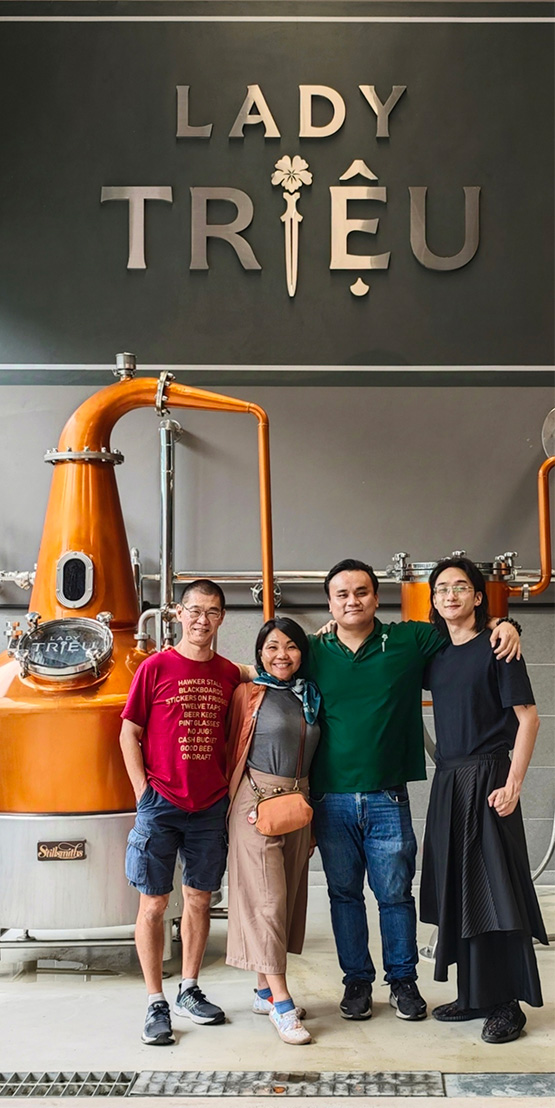
From left: Meng-Chao (Sub-Editor), Kim Choong (Editor-in-Chief), Javin Chia (Master Distiller of Lady Trieu), and Glenn Chew (a friend).
About the brand
The gin's name comes from Lady Triệu, a third century female warrior in Vietnam. Legend paints her as seven feet tall, riding into battle on an elephant with a sword in hand. Fact and folklore blur, but her spirit of defiance endures. “She’s like our Joan of Arc,” Javin said. “She probably existed, but the stories make her larger than life.”
The hibiscus emblem combined with Lady Triệu’s sword on the bottle symbolises nature’s fragility and the responsibility to protect it. "Blooming for just one day, the hibiscus reminds us," Javin said, “that nature is precious, and it is our duty to source its vibrant ingredients sustainably.”
The ethos of Lady Triệu also extends to the team behind the gin. The distillery employs equal number of women and men. Among them is Javin's assistant, Nguyen Thi Tuyết, a graduate of Ho Chi Minh University of Technology with several years of R&D experience and in the F&B industry.
By the end of the tour, the science has dissolved into taste. Glasses of gin are passed around, each carrying the scent of place: the floral rush of Dalat, the spice of Hoi An, tea hill of Sapa, the citrus of the Mekong. It’s Vietnam mapped in botanicals, bottled in Củ Chi.
Walking out into the Củ Chi air, I realised what made the experience memorable wasn’t just the gin in my glass. It was the sense of place in every drop — that Vietnam’s landscapes, markets, and stories could be distilled into spirit. I left with the taste of hibiscus and juniper still on my tongue, and the certainty that Lady Triệu was more than a distillery. It was a storyteller, and I had just been lucky enough to listen.
Lady Triệu Gin was officially launched in Malaysia in September 2025. For more information, visit their website.
- T -
